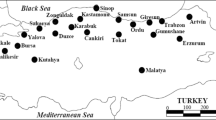Abstract
In Belgium, recently two new red carmine forms of Tetranychus sp. have appeared on tomato crops in glasshouses and in maize crops. These forms maintain their red colour even during summer and on other host plants such as French bean. Our aim was to establish their status and to compare them with strains of Tetranychus urticae and Tetranychus cinnabarinus. A strain of Tetranychus kanzawai, a distant relative of the same genus, was used as a control. The five strains tested were characterized by their own demographic parameters, probably because of a longseparated evolution on different host plants. The white eye strain of T. urticae was differentiated from the four other strains by scanning electron microscopy studies of the dorsal integument folds. An investigation using the random amplified polymorphic DNA-polymerase chain reaction (RAPD-PCR) showed T. cinnabarinus as a distinct group. However, the mixing of the individuals of the four other strains raises the question of the role of hybridization and host plant selection in the evolution of the Tetranychus complex. Exp Appl Acarol 22: 649–666 © 1998 Kluwer Academic Publishers
Similar content being viewed by others
REFERENCES
Baker, E.W and Pritchard, A.E. 1960. The Tetranychoid mites of Africa. Hilgardia 29(11): 455-575.
Black, W.C., IV 1993. PCR with arbitary primers: approach with care. Insect Mol. Biol. 2(1): 1-6.
Boudreaux, H.B. and Dosse, G. 1963. The usefulness of new taxonomic characters in females of the genus TetranychusDufour. Acarologia V(1), 13-33.
Dupont, L.M. 1979. On gene flow between Tetranychus urticaeKoch, 1836 and Tetranychus cinnabarinus(Boiduval) Boudreaux, 1956 (Acari: Tetranychidae): synonymy between the two species. Entomol. Exp. Appl. 25: 297-303.
Fry, J.D. 1989. Evolutionary adaptation to host plant in a laboratory population of the phytophagous mite Tetranychus urticaeKoch. Oecologia 81: 559-565.
Gotoh, T., Bruin, J., Sabelis, M.W., and Menken, S.B.J. 1993. Host race formation in Tetranychus urticae: genetic differentiation, host plant preference, and mate choice in a tomato and a cucumber strain. Entomol. Exp. Appl. 68: 171-178.
Gutierrez, J., Helle, W. and Bolland, H.R. 1970. Etude cytogénétique et réflexions phylogénétiques sur la famille des Tetranychidae Donnadieu. Acarologia 11(4): 732-751.
Hance, T. and Lastelle, C. 1994. The use of RAPD-PCR techniques for the characterisation of Aphid clones. In First Benelux Congress of Zoology, Soc. R. Zool. Belg. (ed.), Leuven p. 70.
Hance, T., Nihoul, P. and Van Impe, G. 1991. Infestation d'acariens tétranyques en culture de maïs en Belgique. Agricontact 226: 1-3.
Hatzinikiolis, E.N. 1970. Contribution à l'étude de l'espéce Tetranychus telarius(Linnaeus, 1758) (Complex) (Acarina: Tetranychidae). Annls Inst. phytopathol. Benaki N.S. 9: 207-218.
Helle, W. and Overmeer, W.P.J. 1973. Variability in Tetranychid mites. Ann. Rev. Entomol. 18: 97-120.
Helle, W. and Pieterse, A.H. 1965. Genetic affinities between adjacent populations of spider mites (Tetranychus urticaeKoch). Entomol. Exp. Appl. 8: 305-308.
Kennedy, J.S. and Hance, Th. 1995. Varietal screening based on demographic parameters: resistance of tea to Brevipalpus phoenicis(Acari: Tenuipalpidae). Environ. Entomol. 24(6): 1481-1486.
Lance, G.N and Williams, W.T. 1967. A general theory of classification sorting strategies. I. Hierarchical systems. Computer J. 9: 373-380.
Landry, B.S., Dextraze, L. and Boivin, G. 1993. Random amplified polymorphic DNA markers for DNA fingerprinting and genetic variability assessment of minute parasitic wasp species (Hymenoptera: Mymaridae and Trichogrammatidae) used in biological control programs of phytophagous insects. Genome 36: 580-587.
Lapointe, F.-J. and Legendre, P. 1992. Statistical significance of the matrix correlation coefficient for comparing independent phylogenetic trees. Syst. Biol. 41(3): 378-384.
Legendre, L. and Legendre, P. 1979. Écologie Numérique. 2. La Structure des Données Écologiques. Massons, Paris.
Legendre, P. and Vaudor, A. 1991. Progiciel R, Analyse Multidimentionnelle, Analyse Spatiale. Université de Montréal, Montréal, Canada.
Monroe, R.S. 1962. A genetic study of members of the Tetranychus telarius(L.) complex. MS thesis, Louisiana State University, Baton Rouge.
Navajas, M., Gutierrez, J., Bonato, O., Bolland, H.R. and Mapangou-Divassa, S. 1994. Intraspecific diversity of the cassava green mite Mononychellus progresivus(Acari: Tetranychidae) using comparisons of the mithochondrial and nuclear ribosomal DNA sequences and cross-breeding. Exp. Appl. Acarol. 18: 351-360.
Navajas, M., Gutierrez, J. and Gotoh, T. 1997. Convergence of molecular and morphological data reveals phylogenetic information on Tetranychusspecies and allows the restoration of the genus Amphitetranychus(Acari: Tetranychidae). Bull. Entomol. Res. 87: 283-288.
Raltson, M.L. and Jenrich, R.I. 1978. D.U.D., a derivative free algorithm for non linear least squares. Technometrics 20: 7-14.
SAS Institute. 1985. SAS User's Guide: Statistics. Version 5. SAS Institute, Cary, NC.
Sneath, P.H.A. and Sokal, R.R. 1973. Numerical Taxonomy - the Principles and Practice of Numerical Classification. W.H. Freeman, San Francisco.
Sokal, R.R. and Michener, C.D. 1958. A statistical method for evaluating systematic relationships. Univ. Kansas Sci. Bull. 38: 1409-1438.
Van de Bund, C.F. and Helle, W. 1960. Investigations on the Tetranychus urticaecomplex in North West Europe (Acari: Tetranychidae). Entomol. Exp. Appl. 3: 142-156.
Van Impe, G. 1991. De la difficulté de désigner correctement un organisme vivant. Le cas du Tétranyque tisserand, Tetranychus urticaeKoch, 1836 (Acari: Tetranychidae). Bull. Ann. Soc. R. Belg. Entomol. 127: 71-76
Van Impe, G. and Hance, T. 1993. Une technique d'évaluation de la sensibilité variétale au Tétranyque tisserand Tetranychus urticaeKoch (Acari: Tetranychidae). Application au haricot, au concombre, à la tomate et au fraisier. Agronomie 13: 739-749.
Veerman, A. 1974. Carotenoid metabolism in Tetranychus urticaeKoch (Acari: Tetranychidae). Comp. Biochem. Physiol. 47B: 101-106.
Author information
Authors and Affiliations
Rights and permissions
About this article
Cite this article
Hance, T., Neuberg, P. & Noèl-Lastelle, C. The use of fecundity, lobe biometry and the RAPD-PCR technique in order to compare strains of Tetranychus sp.. Exp Appl Acarol 22, 649–666 (1998). https://doi.org/10.1023/A:1006010822267
Issue Date:
DOI: https://doi.org/10.1023/A:1006010822267




